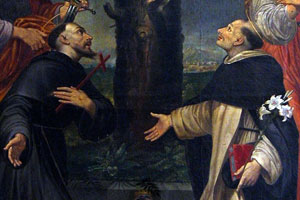The Basilica of the Servants of Mary
The Mendicant Orders
The mendicant orders constitute a truly innovative element in history, a new model of Christian life, kindled by the Holy Spirit in the twelfth century. Until then monasticism, born when the era of the martyrs came to an end, represented the ideal of Christian life, the sign of total dedication to God. In the monasteries, safe oases during the time of the barbarian invasions and great social upheaval of the early Middle Ages, it had been possible to preserve the Christian values and cultural richness generated by the encounter between Graeco-Roman civilization and the Gospel. By now well-established, the monastic orders manifested between the tenth and the twelfth centuries an intense and diversified movement of reform oriented towards the return of religious life to the simplicity of the origins and the reform of the entire Church. Nonetheless, the transformations brought by the resumption of trade and the rebirth of towns, as well as the ever-present need for Christians to convert to the original model of the early Church, generated a widespread spiritual ferment of preachers who forcefully called for conversion. In large part these preachers, such as Pietro Valdo, and their followers, began with the authorization of the hierarchy, but the fact that they vehemently attacked the Church structure soon transformed them into heretical movements emphasizing to a fault certain . . .



